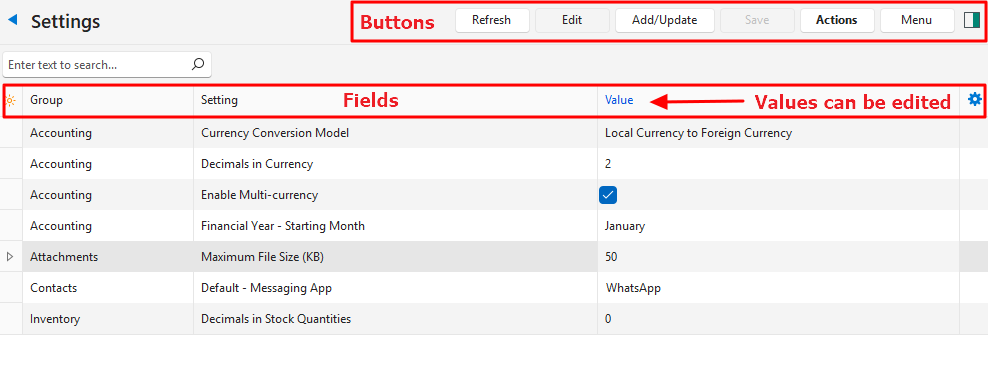- Home
- Knowledge Base
- Getting Started
- General Settings
General Settings
- Certain settings affect multiple modules and are commonly referred to as general settings.
- Each setting has a default value. It is only necessary to add the setting to change the default value.
- When Add/Update (button) is clicked, only those settings that have not been added to the list are displayed, however, there is a checkbox to Show All settings.
Navigation: Main Menu > Setup > Settings
General Settings Interface

Buttons Explained
| Button | Description |
|---|---|
| Refresh | Refreshes the display. |
| Edit | Allows users to edit the fields in the Value column. |
| Add/Update | Allows users to add settings to change their default values. |
| Save | Saves any changes. |
| Actions | Delete: Allows users to delete the entry. |
| Menu | Layout |
Fields Explained
| Field | Description |
|---|---|
| Field Chooser (*) | Allows users to add or remove columns. |
| Editor | The system-generated number for the Language Editor. |
| ID | The system-generated number for the entry. |
| ModuleID | The system-generated number for the Module. |
| Group | The name of the Group to which the setting belongs. |
| Setting | A description of the Setting. |
| Value | The editable Values for the setting. |
| Created | The dateon which the entry was created. |
| Updated | The dateon which the entry was updated. |
| Updated By | The User who last updated the entry. |
| Widget | A submenu that allows the entry to be Deleted. Settings that are deleted are removed from the interface and revert to their default values. |
Add/Update Interface Explained
When Add/Update (button) is clicked on the main list of settings, users are transferred to this interface.
Buttons and Filters Explained
| Button | Description |
|---|---|
| Add/Update (button) | Adds the selected records to the Settings interface. |
| Show All (checkbox) | Checkbox. If checked all the available settings are shown, including those that have already been added to the Settings interface. |
Fields Explained
| Field | Description |
|---|---|
| Field Chooser (*) | Allows users to add or remove columns. |
| ID | The system-generated number for the setting. |
| Group | The Group that the setting affects (e.g. Timekeeping, Accounting). |
| Setting | A description of the setting. |
| Default Value | The setting’s Default Value that can be changed after the setting is Added/Updated. |
Settings Explained
This section describes the function of the settings.
| Setting | Description | Default |
|---|---|---|
| Accounting > Currency Conversion Model | The available options are: – Local Currency to Foreign Currency (How much of the foreign currency can one unit of the local currency buy?) – Foreign Currency to Local Currency (How much of the local currency can one unit of the foreign currency buy?) | Local Currency to Foreign Currency |
| Accounting > Decimals in Currency | The amount of decimal numbers to use when converting currencies. Choose 2 or 3. | 2 |
| Accounting > Enable Multi-currency | Checkbox: – If checked, multi-currency is enabled. – If unchecked, the currency lookups and columns in the Customer Age Analysis, Supplier Age Analysis, Ledger, and Transactions are disabled. | Unchecked |
| Accounting > Financial Year – Starting Month | A dropdown list of months for users to select in which month their financial or fiscal year starts. | January |
| Attachments > Maximum File Size (KB) | The maximum file size that can be uploaded when using the Notes & Attachment feature. If this size is exceeded when uploading an attachment, an error message is displayed. Captured Images (e.g. from a camera) are resized to Max FHD 1920×1080. | 50 KB |
| Contacts > Default – Messaging App | A field to type in the name of the default messaging app. This name appears on forms for users to type in the applicable number. | |
| Inventory > Decimals in Stock Quantities | A dropdown list to select from 0 to 4 decimals. | 0 |
| Items > Enable Item Types | Allows users to select which item types to enable. The options are: – Material: A general all-purpose item. – Task: A general service-related item, or item that is part of a costing or assembly. – Outwork: Services or products that are outsourced. – Costing: A collection of items used to calculate a cost and selling price. – Substrate (Sheets): Applicable to industries that use substrate sheets (e.g. printing). – Substate (Reels): Applicable to industries that use substrate reels (e.g. printing). – Assembly: Allows items to be combined to incorporate all the processes in production and costings. Used for a bill of materials. – Substrate (Square Meters): Applicable to industries that use substrates that are measured in square metres (e.g. printing). | Material, Task |
Tutorials
How to Add General Settings
- Navigate to Settings.
- Click Add/Update (button).
- Click any settings that appear on the list. (Use Ctrl + Left Click to multi-select).
- Note: Settings that you previously added are not shown. To see them, check the checkbox next to Show All. If a setting is added twice, it is not duplicated. It will only appear once.
- If the default values (as explained on the tab Settings Explained) meet your needs, you do not have to add the setting.
- Click Add/Update (button).
- Confirm that you want to add the setting.
- Edit the settings as needed.
How to Edit General Settings
- Navigate to Settings.
- Click Edit (button).
- Click the Value column next to the setting you want to edit.
- Make the necessary changes.
- Click Save (button).
